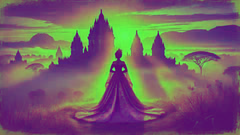Introduction
There’s a place along the windswept coast of Hawke’s Bay, where the waves of the Pacific Ocean shimmer with secrets and the land breathes with stories older than memory. Here, in the heart of Aotearoa, the people of Napier look out over the restless waters and remember a love that once bridged the chasm between human longing and the mysteries of the sea. The legend of Pania of the Reef, whispered from generation to generation, is more than a tale—it’s a living spirit, a reminder that in New Zealand, every stone, wave, and breeze carries the echoes of its ancient past. In the time when the world was young and the boundaries between realms were as thin as the spray on the surf, the tribes of the East Coast lived in harmony with the land, their stories woven into the hills and rivers, their lives watched over by gods and taniwha, guardians both gentle and fierce. Among the people of the great fortified pa called Te Kauwae-a-Maui, life unfolded to the rhythms of the tide and the migration of birds. Yet, beneath the surface, the sea was a realm of its own—wild, abundant, and inhabited by beings both wondrous and strange. Fishermen told tales of beautiful maidens glimpsed in the foam at dawn, vanishing at the first ray of sun, their laughter echoing like bellbirds across the breakers. Some claimed these were patupaiarehe, fairy folk of the sea; others said they were the daughters of Tangaroa, lord of oceans. Few believed such tales until the day a love so deep and tragic unfolded that it left its mark forever on the very stones of the reef. This is the story of Pania—a sea maiden whose beauty outshone the moon, whose heart dared to bridge the world of men and the mysteries of the deep. It is a story of enchantment, joy, and sorrow, set against the wild, untamed beauty of New Zealand’s coast. And as the wind sighs through the flax and the waves whisper over the stones, Pania’s legend endures, a beacon of longing and hope beneath the Southern stars.
The Meeting of Two Worlds
On a night when the moon hung low and full above Te Whanganui-a-Orotu—the great bay that curves around Napier—a hush settled over the land and sea. The tides breathed in and out like a sleeping giant, and the ancient pohutukawa trees along the cliff tops seemed to lean closer, eager for the story about to unfold.

Karitoki, a young chief from the tribe of Ngati Kahungunu, was restless. Though his life was graced by mana and tradition, by day he hunted with his people and by night he sat around the great fires listening to elders recount the deeds of ancestors, something in his soul remained unquiet. Karitoki was not satisfied by feats of hunting or the promise of leadership. He was drawn always to the sea, to the hush and roar of the surf, to the unknown that shimmered beyond the last pale line of foam. Sometimes, late at night, he would slip away from the safety of his people and wander down the shingle shore, letting the cold waves rush around his ankles, his mind adrift with dreams he could not name.
On one such night, as clouds drifted across the moon and silvered the breakers, Karitoki followed a faint, haunting melody. It was lighter than wind, sweeter than the tui’s song at dawn, and yet it thrummed with a sadness that tugged at his heart. Drawn by curiosity and longing, he made his way down to the edge of the reef, where the rocks jutted out like teeth into the restless sea. There, half-hidden by a curtain of kelp and foam, he saw her.
Pania was unlike any woman he’d ever known. Her hair tumbled like black water over her shoulders, and her skin shimmered with a light that seemed both moonlit and ocean-deep. Her eyes were dark pools, holding secrets as old as Tangaroa himself. She was garbed in a cloak woven from the finest flax and adorned with shells that glimmered like stars. She sang to the sea, her voice a bridge between sorrow and hope.
Karitoki watched, spellbound, as she danced lightly across the rocks, her feet barely disturbing the spray. When she noticed him, she did not flee. Instead, she smiled—a smile both shy and daring—and beckoned him closer. His heart hammered in his chest as he stepped forward, uncertain if he was dreaming or awake.
They spoke in soft voices, halting at first, as if testing the boundaries of this chance encounter. Pania revealed little about herself, only that she was of the sea, a child of Tangaroa, who came to the shore by night when the world slept. Karitoki, in turn, spoke of his people, of the land’s beauty and hardship, and of his own restless heart.
Night after night, Karitoki returned to the reef. Under the cover of darkness, they shared stories and laughter, each encounter weaving their destinies tighter. With every meeting, his love for Pania grew—a love as vast and fierce as the Pacific. He wondered if she felt the same ache, the same longing for something beyond the horizon. Pania, too, found herself torn between two worlds. The sea was her home, her birthright, but the warmth she found in Karitoki’s presence called to something wild and human inside her. In his arms she discovered a tenderness she had only glimpsed in dreams.
The moon became their silent witness. As the tides changed and the seasons shifted, their love deepened. Yet always, Pania warned Karitoki that her time on land was borrowed. When dawn broke, she must return to her sisters beneath the waves, for the ocean called her back with a pull as inexorable as fate. Still, they cherished every precious night, weaving promises of forever beneath the endless southern sky.
Love and Shadows on the Shore
As the weeks passed, the bond between Karitoki and Pania grew stronger, yet also more fragile. In the hush before dawn, when Pania slipped back into the sea, Karitoki felt emptier than before he’d known her. The world seemed sharper—every star brighter, every wave more restless. Yet he was haunted by the knowledge that Pania belonged to another realm.

Desire and anxiety warred within him. He longed for a way to keep Pania by his side in the daylight, to make her part of his world as much as she was of the sea’s. He pleaded with her to stay, to walk with him through the pa at sunrise, to share his life openly. But Pania was bound by ancient laws: if she lingered on land past dawn, the sea would reclaim her forever.
Despite this, Pania’s yearning matched Karitoki’s. She loved him fiercely, and each night when she emerged from the surf, she did so with joy and trembling anticipation. They crafted secret rituals—gathering shells as tokens, plaiting strands of hair into each other’s cloaks, weaving dreams into reality for a few precious hours. The night world was theirs alone, hidden from the eyes of Karitoki’s kin and Pania’s watery sisters.
But in a small village, secrets seldom stay hidden. One night, as Karitoki returned to the pa at dawn’s edge, he was spotted by his cousin. Whispers began to circulate—strange lights at the reef, Karitoki’s absences, laughter echoing over the surf. The elders grew uneasy. They knew that when mortal men consorted with beings from the other world, trouble often followed. The lines between blessing and curse blurred easily along the coast.
Karitoki’s mother, a wise woman deeply attuned to the spirit world, confronted her son. He confessed everything—his love for Pania, her otherworldly origins, and his desire to bind her to him forever. Fearing for his safety, his mother warned him: 'The sea is generous, but it is also jealous. If you seek to trap what belongs to Tangaroa, sorrow will surely follow.'
Tormented by these warnings but unable to let go, Karitoki sought counsel from an old tohunga, a priest whose knowledge of magic was revered and feared. The tohunga listened with grave patience and told Karitoki of a plant called karaka. Its leaves, when chewed or steeped in water, could sometimes break enchantments—or bind a spirit to mortal flesh. But such power came at a cost.
Desperate, Karitoki begged Pania to remain with him for a single sunrise. He pressed upon her a cloak woven with karaka leaves, telling her it was a gift—a symbol of their love and his wish to keep her warm through the chill of dawn. Pania, torn between trust and dread, donned the cloak as darkness faded. As the first light crept over the horizon, she felt a heaviness in her limbs—a strange weariness seeping into her bones.
Pania realized too late what Karitoki had done. The karaka leaves sapped her strength, anchoring her to land. She gazed at Karitoki with anguish—a love betrayed not by malice, but by fear and longing. The call of the sea grew louder, wild and mournful. Her sisters’ voices rose from beneath the surf, summoning her home.
With tears streaming down her face, Pania tore off the cloak and ran toward the waves. Karitoki chased after her, his cries lost in the crashing surf. As she reached the water’s edge, the ocean opened its arms, embracing her. In a flash of silver and green, Pania vanished beneath the foam, leaving only her cloak tangled on the rocks and a heartbroken chief behind.
The Reef’s Eternal Lament
The sea was restless that morning. The wind keened over the reef, and clouds raced across the sky as if in mourning. Karitoki searched frantically along the shore for any sign of Pania—her laughter, her song, even a single strand of her hair. But she was gone, drawn back to the deep by forces older and stronger than any mortal love.

For days, Karitoki wandered the coastline, refusing food or rest. The people of Te Kauwae-a-Maui watched with heavy hearts as their chief faded before their eyes. Sometimes, at dusk, he would sit among the rocks and sing the old love songs, hoping against hope that Pania might return. Some claimed they saw her shadow moving in the foam, or heard her voice on the wind, calling his name from beneath the waves. Yet she never came back to land.
Pania’s sisters welcomed her home with open arms but also with grief. She had tasted human love and paid the price—a longing that could never be fully healed. From then on, Pania swam among the reefs near Napier, watching over the shore and her beloved from afar. She became both guardian and mourner, her spirit woven into every tidepool and every breaking wave.
In time, Karitoki came to accept that his love could not bridge the gulf between land and sea. He honored Pania’s memory by planting karaka trees along the headlands and teaching his people to respect both the gifts and dangers of the ocean. The reef where they met became sacred—an altar of longing and remembrance.
The legend says that on certain nights, when the moon is bright and the tide is high, Pania can be seen dancing among the waves, her laughter mingling with the cry of gulls. Fishermen who stray too close to the reef speak of glimpsing a beautiful maiden beckoning from the surf or feeling an inexplicable sadness settle over them. To this day, children are warned not to pick karaka leaves from the trees near the shore, lest they disturb the delicate balance between worlds.
Pania’s story lives on in stone and song. A statue of her graces the waterfront at Napier, gazing eternally out to sea. She is remembered not only as a symbol of beauty and loss but also as a protector—a reminder that love, in all its forms, is both a gift and a mystery. The reef endures, battered by storms and caressed by sun, its rocks whispering her name in every crashing wave.
Conclusion
Pania’s legend endures along New Zealand’s eastern coast, not just as a tale of lost love but as a lesson woven deep into the culture of Aotearoa. It reminds all who listen that some boundaries can never be crossed without consequence—that love is most profound when it honors freedom, even at great personal cost. The relationship between land and sea remains sacred here; Pania’s story warns against greed or the desire to possess what belongs to another world. Instead, it celebrates connection, guardianship, and respect for the mysteries that shape our lives. In Napier today, visitors and locals alike pause by Pania’s statue or walk along the reef at dusk, feeling the ancient heartbeat of place and legend. The whispers of the tide carry her song—a melody of hope, longing, and the promise that beauty can persist, even through sorrow. So long as the waves break on Napier’s reef and the moon rises over Hawke’s Bay, Pania’s story will be told, forever part of the living soul of New Zealand.


















